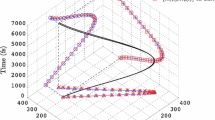Abstract
It is shown how, starting with the de Broglie–Bohm pilot-wave theory, one can construct a new theory of the sort envisioned by several of QM’s founders: a Theory of Exclusively Local Beables (TELB). In particular, the usual quantum mechanical wave function (a function on a high-dimensional configuration space) is not among the beables posited by the new theory. Instead, each particle has an associated “pilot-wave” field (living in physical space). A number of additional fields (also fields on physical space) maintain what is described, in ordinary quantum theory, as “entanglement.” The theory allows some interesting new perspective on the kind of causation involved in pilot-wave theories in general. And it provides also a concrete example of an empirically viable quantum theory in whose formulation the wave function (on configuration space) does not appear—i.e., it is a theory according to which nothing corresponding to the configuration space wave function need actually exist. That is the theory’s raison d’etre and perhaps its only virtue. Its vices include the fact that it only reproduces the empirical predictions of the ordinary pilot-wave theory (equivalent, of course, to the predictions of ordinary quantum theory) for spinless non-relativistic particles, and only then for wave functions that are everywhere analytic. The goal is thus not to recommend the TELB proposed here as a replacement for ordinary pilot-wave theory (or ordinary quantum theory), but is rather to illustrate (with a crude first stab) that it might be possible to construct a plausible, empirically viable TELB, and to recommend this as an interesting and perhaps-fruitful program for future research.
Similar content being viewed by others
References
Einstein, A.: Concerning an heuristic point of view toward the emission and transformation of light. Am. J. Phys. 33(5), 367–374 (1965). A.B. Arons, M.B. Peppard, trans.
Wigner, E.P.: Thirty years of knowing Einstein. In: Woolf, H. (ed.) Some Strangeness in the Proportion. Addison-Wesley, Reading (1980)
Frank, P.: Einstein: his life and times, p. 208. A. Knopf, New York (1963). G. Rosen, trans.
Lorentz, H.A.: Problems of Modern Physics, pp. 156–157. Dover, New York (1967) (a republication of the work originally published by Ginn and Company in 1927)
Slater, J.C.: Solid-State and Molecular Theory: A Scientific Biography, pp. 8–14. Wiley, New York (1975)
Przibam, K. (ed.) Letters on Wave Mechanics, p. 31. The Philosophical Library, New York (1967)
Valentini, A., Bacciagaluppi, G.: Quantum Theory at the Crossroads. Cambridge University Press, Cambridge (2009). quant-ph/0609184
Belousek, D.W.: Einstein’s 1927 unpublished hidden-variable theory: its background, context and significance. Stud. Hist. Philos. Mod. Phys. 27(4), 437–461 (1996)
Holland, P.: What’s wrong with Einstein’s 1927 hidden variable interpretation of quantum mechanics? Found. Phys. 35, 177–196 (2005)
Cushing, J.: Quantum Mechanics: Historical Contingency and the Copenhagen Hegemony. University of Chicago Press, Chicago (1994)
Bohm, D.: A suggested interpretation of the quantum theory in terms of ‘hidden variables’. Phys. Rev. 85, 166–193 (1952)
Howard, D.: ‘Nicht Sein Kann Was Nicht Sein Darf,’ or the Prehistory of EPR, 1909–1935: Einstein’s early worries about the quantum mechanics of composite systems. In: Miller, A.I. (ed.) Sixty-Two Years of Uncertainty. Plenum, New York (1990)
Bell, J.S.: Speakable and Unspeakable in Quantum Theory, 2nd edn. Cambridge University Press, Cambridge (2004)
de Broglie, L.: The Current Interpretation of Wave Mechanics: A Critical Study. Elsevier, Amsterdam (1964)
Freistadt, H.: The causal formulation of quantum mechanics of particles (the theory of De Broglie, Bohm and Takabayasi). Nuovo Cimento 5(1), 1–70 (1957)
Wessels, L.: Schrödinger’s route to wave mechanics. Stud. Hist. Philos. Sci. Part A 10(4), 311–340 (1979). The remark of Eckart is sourced to a May 31, 1962 interview with Eckart conducted by J. Heilbron, under the auspices of the AHQP
Callender, C., Weingard, R.: Trouble in paradise? Problems for Bohm’s theory. The Monist 80(1), 24–43 (1997)
Mermin, N.D.: What’s bad about this habit? Phys. Today 8–9 (2009)
Dürr, D., Goldstein, S., Zanghi, N.: Quantum equilibrium and the origin of absolute uncertainty. J. Stat. Phys. 67, 843–907 (1992)
Dürr, D., Goldstein, S., Tumulka, R., Zanghi, N.: On the role of density matrices in Bohmian mechanics. Found. Phys. 35(3), 449–467 (2005)
Allori, V., Goldstein, S., Tumulka, R., Zanghi, N.: Many-worlds and Schroedinger’s first quantum theory. arxiv:0903.2211
Maudlin, T.: Completeness, supervenience, and ontology. J. Phys. A 40, 3151–3171 (2007)
Bohm, D., Vigier, J.P.: Model of the causal interpretation of quantum theory in terms of a fluid with irregular fluctuations. Phys. Rev. 96, 208–216 (1954)
Anandan, J., Brown, H.R.: On the reality of spacetime geometry and the wavefunction. Found. Phys. 25(2), 349 (1995)
Holland, P.: The Quantum Theory of Motion. Cambridge University Press, Cambridge (1993)
Valentini, A.: On Galilean and Lorentz invariance in pilot-wave dynamics. Phys. Lett. A 228, 215–222 (1997)
Valentini, A., Westman, H.: Dynamical origin of quantum probabilities. Proc. R. Soc. Lond. A 461, 253–272 (2005)
Author information
Authors and Affiliations
Corresponding author
Rights and permissions
About this article
Cite this article
Norsen, T. The Theory of (Exclusively) Local Beables. Found Phys 40, 1858–1884 (2010). https://doi.org/10.1007/s10701-010-9495-2
Received:
Accepted:
Published:
Issue Date:
DOI: https://doi.org/10.1007/s10701-010-9495-2




